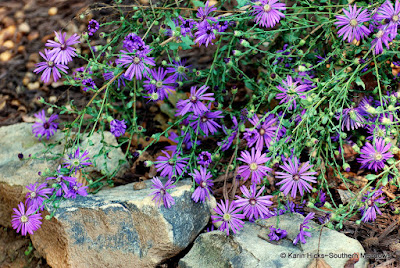Georgia Asters are the grand finale in our fall garden. They are the last blooms to burst open and put on a spectacular display to conclude the fall flowering season.
Aster, the Latin name for star, aptly describes this stellar flower. Georgia asters (
Symphyotrichum georgianum) bloom October through November, but you'll be lucky to see one, save you grow them in your garden.
 |
| Legal Status: THREATENED |
Once common across the Southeast (Georgia, Alabama, South Carolina, North Carolina), Georgia asters have been in decline for decades. According to the Georgia DNR, there are only 15 small populations, 8 of
which occur in state parks or national forest lands, landing this plant on the threatened species list. A conservation partnership of state agencies, together with public and private organizations has been created to boost this wildflower's population and keep it from becoming endangered.
 |
| spectacular show of deep violet blooms |
I purchased our first plant at the Georgia State Botanical Garden back in 2012. This was the first photograph I took of the regal native exhibiting its deep violet colored petals. Since then. I've been able to acquire two additional plants making a generous stand of these astounding asters.
The rays are more of a bluish hue on young blooms transitioning to purple as they age. Its narrow-petaled flowers are about 2" across with a white center. The disk flowers transition from white to purple as they mature. Georgia asters usually spread slowly via underground rhizomes, but have also reseeded in our garden. They do require cross-pollination from another colony to produce viable seeds.
The color is especially magnificent among other late blooming perennials such as Maryland Goldenaster (
Chrysopsis mariana), Goldenrod (
Solidago) and/or Pink Muhly Grass (
Muhlenbergia capillaris). This vibrant combination, pictured below, was a delightful surprise when one of the swamp sunflower (
Helianthus angustifolius) stalks bowed over to say hello.
 |
| a bold autumn combo |
Asters provide a necessary source of rich nectar for pollinators late in the season. This year we've had unseasonably warm temperatures and bees, butterflies, moths and flies are still around in abundance. Unfortunately many plants are suffering severely because of our drought conditions, causing many blooms to be very short lived.
 |
| a dainty flower fly visiting Georgia aster |
Native bees are particularly attracted to these intensely colored asters. I often find the bees sleeping soundly in the early morning hours when temperatures are cool. Bees need 50 degrees Fahrenheit or higher to fly efficiently, so they don't use up their nectar stores.
As is typical on plants in our garden, there are other insects lurking about the blooms. When I was out photographing for this post, a crab spider was making its way from the back side of the flower while the bee was focused on feeding. Crab spiders are amazingly patient, often remaining in the same place for weeks before moving in on prey.
 |
| Can you find the crab spider? It blends in with the plant stalk |
I couldn't tell if the spider was intimidated by the size of the bee or not, but this bee wasn't messing around. It chased the spider out of its hiding spot rather quickly once it became aware it was lurking in the shadows.
 |
| A reversal of prey and predator |
Asters are incredibly versatile in the landscape and this Georgia aster is no exception. It's bold, providing a profusion of late-season color, while supporting pollinators. If you can get your hands on a plant, I highly recommend adding this specimen to your garden. It prefers a dry, sunny location but will tolerate filtered shade, although may not bloom as liberally.
It is
Wildflower Wednesday and I encourage you to take a look at the remarkable contributing blogs. For a list, hop over to our wonderful host, Gail at Clay and Limestone.











